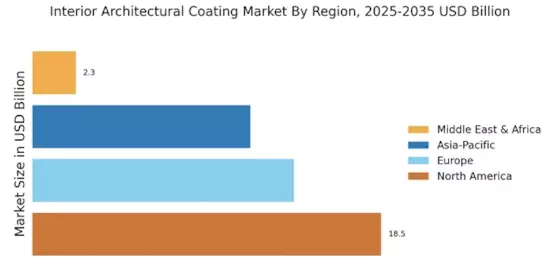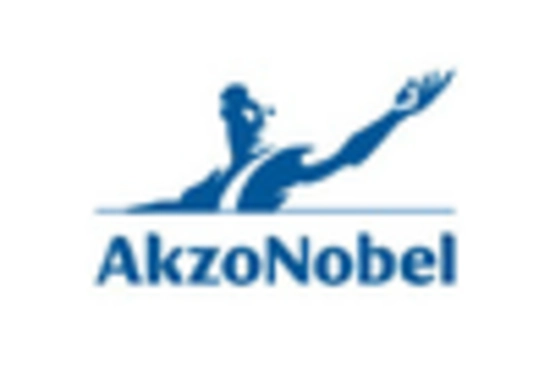The Interior Architectural Coating Market is currently characterized by a dynamic competitive landscape, driven by innovation, sustainability, and regional expansion. Major players such as Sherwin-Williams (US), PPG Industries (US), and AkzoNobel (NL) are actively shaping the market through strategic initiatives. Sherwin-Williams (US) has positioned itself as a leader in eco-friendly coatings, focusing on sustainable product development and enhancing its distribution network. PPG Industries (US) emphasizes technological advancements in its product offerings, particularly in smart coatings that respond to environmental changes. Meanwhile, AkzoNobel (NL) is leveraging its global presence to expand into emerging markets, thereby enhancing its competitive edge. Collectively, these strategies indicate a shift towards a more sustainable and technologically advanced market environment.
In terms of business tactics, companies are increasingly localizing manufacturing to reduce lead times and optimize supply chains. This approach not only enhances operational efficiency but also allows for better responsiveness to regional market demands. The competitive structure of the Interior Architectural Coating Market appears moderately fragmented, with several key players exerting influence. The collective actions of these companies suggest a trend towards consolidation, as they seek to enhance their market share and operational capabilities.
In August 2025, Sherwin-Williams (US) announced the launch of a new line of low-VOC interior paints, which aligns with the growing consumer demand for environmentally friendly products. This strategic move not only reinforces the company's commitment to sustainability but also positions it favorably against competitors who may not prioritize eco-conscious offerings. The introduction of these products is likely to attract a broader customer base, particularly among environmentally aware consumers.
In September 2025, PPG Industries (US) unveiled a partnership with a technology firm to develop AI-driven color matching solutions for its interior coatings. This initiative is significant as it enhances customer experience by providing personalized solutions, thereby differentiating PPG in a competitive market. The integration of AI into their product offerings may also streamline operations and reduce costs, further solidifying PPG's market position.
In July 2025, AkzoNobel (NL) completed the acquisition of a regional coatings manufacturer in Southeast Asia, which is expected to bolster its market presence in this rapidly growing region. This acquisition not only expands AkzoNobel's production capabilities but also enhances its distribution network, allowing for more efficient service delivery. Such strategic moves indicate a proactive approach to capturing market share in emerging economies, which are becoming increasingly important in the global landscape.
As of October 2025, the competitive trends in the Interior Architectural Coating Market are heavily influenced by digitalization, sustainability, and technological integration. Companies are forming strategic alliances to enhance their capabilities and market reach, reflecting a collaborative approach to competition. The shift from price-based competition to a focus on innovation, technology, and supply chain reliability is evident, suggesting that future competitive differentiation will hinge on these factors. As the market evolves, companies that prioritize sustainable practices and technological advancements are likely to emerge as leaders.


















Leave a Comment